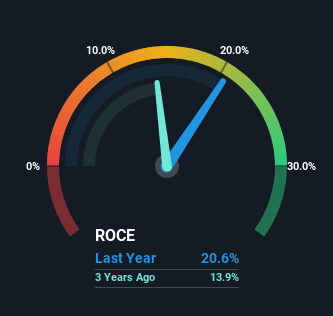- Australia
- /
- Basic Materials
- /
- ASX:JHX
Why You Should Care About James Hardie Industries' (ASX:JHX) Strong Returns On Capital

Did you know there are some financial metrics that can provide clues of a potential multi-bagger? In a perfect world, we'd like to see a company investing more capital into its business and ideally the returns earned from that capital are also increasing. This shows us that it's a compounding machine, able to continually reinvest its earnings back into the business and generate higher returns. With that in mind, the ROCE of James Hardie Industries (ASX:JHX) looks attractive right now, so lets see what the trend of returns can tell us.
Return On Capital Employed (ROCE): What Is It?
For those that aren't sure what ROCE is, it measures the amount of pre-tax profits a company can generate from the capital employed in its business. The formula for this calculation on James Hardie Industries is:
Return on Capital Employed = Earnings Before Interest and Tax (EBIT) ÷ (Total Assets - Current Liabilities)
0.21 = US$778m ÷ (US$4.5b - US$697m) (Based on the trailing twelve months to March 2023).
Therefore, James Hardie Industries has an ROCE of 21%. In absolute terms that's a great return and it's even better than the Basic Materials industry average of 3.5%.
Check out our latest analysis for James Hardie Industries

Above you can see how the current ROCE for James Hardie Industries compares to its prior returns on capital, but there's only so much you can tell from the past. If you'd like to see what analysts are forecasting going forward, you should check out our free report for James Hardie Industries.
SWOT Analysis for James Hardie Industries
- Earnings growth over the past year exceeded the industry.
- Debt is well covered by earnings and cashflows.
- Earnings growth over the past year is below its 5-year average.
- Dividend is low compared to the top 25% of dividend payers in the Basic Materials market.
- Annual earnings are forecast to grow faster than the Australian market.
- Current share price is below our estimate of fair value.
- Dividends are not covered by cash flow.
- Revenue is forecast to grow slower than 20% per year.
How Are Returns Trending?
We'd be pretty happy with returns on capital like James Hardie Industries. The company has consistently earned 21% for the last five years, and the capital employed within the business has risen 93% in that time. With returns that high, it's great that the business can continually reinvest its money at such appealing rates of return. If these trends can continue, it wouldn't surprise us if the company became a multi-bagger.
Our Take On James Hardie Industries' ROCE
James Hardie Industries has demonstrated its proficiency by generating high returns on increasing amounts of capital employed, which we're thrilled about. Therefore it's no surprise that shareholders have earned a respectable 92% return if they held over the last five years. So even though the stock might be more "expensive" than it was before, we think the strong fundamentals warrant this stock for further research.
On a final note, we found 2 warning signs for James Hardie Industries (1 is a bit unpleasant) you should be aware of.
If you want to search for more stocks that have been earning high returns, check out this free list of stocks with solid balance sheets that are also earning high returns on equity.
If you're looking to trade James Hardie Industries, open an account with the lowest-cost platform trusted by professionals, Interactive Brokers.
With clients in over 200 countries and territories, and access to 160 markets, IBKR lets you trade stocks, options, futures, forex, bonds and funds from a single integrated account.
Enjoy no hidden fees, no account minimums, and FX conversion rates as low as 0.03%, far better than what most brokers offer.
Sponsored ContentNew: Manage All Your Stock Portfolios in One Place
We've created the ultimate portfolio companion for stock investors, and it's free.
• Connect an unlimited number of Portfolios and see your total in one currency
• Be alerted to new Warning Signs or Risks via email or mobile
• Track the Fair Value of your stocks
Have feedback on this article? Concerned about the content? Get in touch with us directly. Alternatively, email editorial-team (at) simplywallst.com.
This article by Simply Wall St is general in nature. We provide commentary based on historical data and analyst forecasts only using an unbiased methodology and our articles are not intended to be financial advice. It does not constitute a recommendation to buy or sell any stock, and does not take account of your objectives, or your financial situation. We aim to bring you long-term focused analysis driven by fundamental data. Note that our analysis may not factor in the latest price-sensitive company announcements or qualitative material. Simply Wall St has no position in any stocks mentioned.
About ASX:JHX
James Hardie Industries
Engages in the manufacture and sale of fiber cement, fiber gypsum, and cement bonded building products for interior and exterior building construction applications primarily in the United States, Australia, Europe, New Zealand, and the Philippines.
Excellent balance sheet and good value.
Similar Companies
Market Insights
Community Narratives



